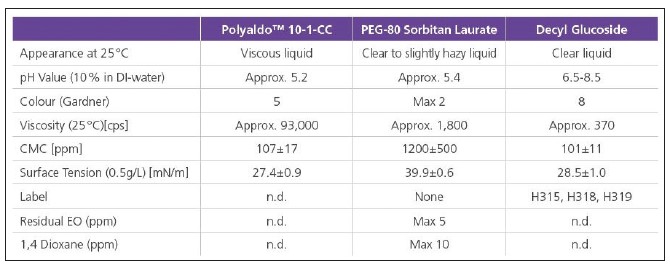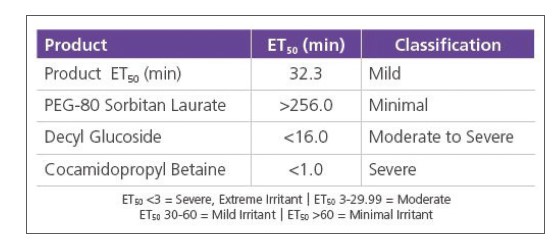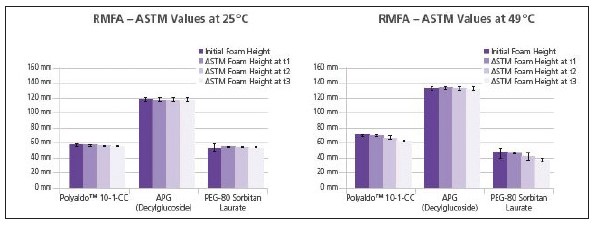AN IDEAL FOAMING AGENT FOR PERSONAL CARE FORMULATIONS: POLYALDO 10-1-CC
The need for mild surfactants for cleansing applications grows at a consistent pace. Consumers are looking for alternatives to traditional surfactants which are known irritants to skin and can cause damage to hair.
The demand for “natural” chemistries further drives up the need for alternative surfactant technologies. To meet these demands, we have created a non-ionic
surfactant called Polyaldo™ 10-1-CC polyglyceryl ester based on our polyglyceryl ester technology.
This naturally- derived polyglyceryl ester offers the best of both worlds: improved quality of foam whist exhibiting a very low irritation profile.
The following article compares the foaming properties, surfactancy attributes, and irritation profile of Polyaldo™ 10-1-CC polyglyceryl ester against typically established surfactants found in the marketplace.
Foam studies were performed with the recently launched KRÜSS RMFA, the first instrument for fully automatic foam analysis according to the Ross-Miles standard. The performance results show Polyaldo™ 10-1-CC polyglyceryl ester is a highly performing surfactant with great foaming and a very low irritation profile on skin.
The personal care marketplace has a wide variety of product forms to offer to the consumer. Products designed for cleansing, such as shampoos, body washes, facial cleansers, hand cleansers, and other cleansing systems, are considered an essential part of one’s daily routine. As such, the market demand for innovative cleansing products continues to rise.
Surfactant Basic Properties
To provide a frame of reference when evaluating Polyaldo™ 10-1-CC polyglyceryl ester, two market standard surfactants were included in the study. PEG-80 sorbitan laurate is well-known for mildness on skin. It is found in many cleansing products promoting gentleness such as baby care and products designed for sensitive skin.
Decyl glucoside is an alkyl polyglucose (APG) surfactant chemistry derived from plant-derived alcohols. It is a good skin cleanser and provides excellent flash foaming to cleaning formulations. The typical surfactant properties of the three surfactants are summarized in Tab. 1.
Table 1. Basic properties of Polyaldo™ 10-1-CC, PEG-80 Sorbitan Laurate, and Decyl Glucoside.
In vitro Epidermal and Epiocular Irritation Study
Polyaldo™ 10-1-CC polyglyceryl ester was evaluated in an in vitro MatTek Epiderm™ Skin Irritation Test (SIT) against PEG-80 sorbitan laurate, the typically established surfactant material. Decyl glucoside and cocamidopropyl betaine were included to broaden the scope of the study.
A buffered saline solution was used as a negative control and a 5% sodium dodecyl sulfate (SDS) solution as a positive control. Mean tissue viability percentages were calculated (via software).
A test sample with a mean tissue viability percentage of 50%or more is considered a non-irritant. A sample with a mean tissue viability percentage of 50% or less is considered an irritant.
The results from Tab. 2 show Polyaldo™ 10-1-CC polyglyceryl ester is classified as a non-irritating surfactant material.
PEG- 80 sorbitan laurate, a surfactant known for its mildness on the skin and typically used in baby care, was confirmed to be a non-irritant, as well. Decyl glycoside and cocamidopropyl betaine, which are frequently used in personal care applications, are classified as irritants.
Table 2. Results from an in vitro MatTek Epiderm™ Irritation Study (SIT) Comparing Polyaldo™ 10-1-CC versus PEG-80 Sorbitan Laurate and other benchmark surfactants.
Polyaldo™ 10-1-CC polyglyceryl ester was evaluated in an in vitro MatTek EpiOcular™ eye irritation study against PEG-80 sorbitan laurate, the market standard material.
Again, decyl glucoside and cocamidopropyl betaine were included to broaden the scope of the study. Measurements of EpiOcular ™ tissue viability were made via methyl thaizole tetrazolium (MTT) uptake and reduction.
The mean percent viability for each time point was used to calculate an ET50 (exposure time), which represents the time at which the EpiOcular tissue viability was reduced by 50% compared to control tissues.
The results from Tab. 3 show Polyaldo™ 10-1-CC polyglyceryl ester is classified as a mild eye irritating surfactant compared to PEG-80 sorbitan laurate, which was confirmed to be a minimal eye irritating surfactant. Decyl glucoside and cocamidopropyl betaine are classified as more severe irritants.
Table 3. Results from in vitro MatTek EpiOcular™ Irritation Study comparing Polyaldo™ 10-1-CC versus PEG-80 Sorbitan Laurate and other benchmark surfactants.
Study on Foaming Properties – Foamability and Foam Structure
Experiments were performed at two different temperatures, 25°C and 49°C, according to the ASTM standard. For this, the liquid receiver and reservoir volumes were pre-heated to the desired temperature prior to filling the instrument.
The double-walled glass column of the instrument was kept at the desired temperatures by means of an external circulator, guaranteeing constant liquid and foam temperatures throughout the whole experiment.
For all three surfactants, dilutions of 0.5g/l in distilled water were prepared and measured using the RMFA within 24 hours after sample preparation. Each sample was measured in triplicate.
Fig 1. depicts a comparison of the ASTM standard result values for all three samples investigated at the 25°C and 49°C temperatures. The error bars reflect the standard deviations as obtained from a minimum of three consecutive experiments.
At both temperatures, APG shows a significantly higher initial foam volume and better foam stability than Polyaldo™ 10-1-CC polyglyceryl ester and PEG-80 sorbitan laurate.
Fig 1. Comparison of ASTM standard result parameters for all three samples investigated at 25°C (left) and 49°C (right).
Whereas at 25°C, APG can store about two times more liquid in the foam, at 49°C, the foam density (i.e. wetness) of APG exceeds the one of Polyaldo™ 10-1-CC polyglyceryl ester and PEG-80 sorbitan laurate by only about 50 %.
Again, compared to PEG-80 sorbitan laurate, Polyaldo™ 10-1-CC polyglyceryl ester shows a comparable foam density at 25°C but a significantly higher one at 49°C. To summarize, compared to APG, Polyaldo™ 10-1-CC polyglyceryl ester shows minor foaming properties in terms of initial foam height, foam stability and wetness, but is clearly compatible with PEG-80 sorbitan laurateat 25°C and even outperforms it at elevated temperatures.
At 25°C the foam structure and the aging behavior of Polyaldo™ 10-1-CC polyglyceryl ester are comparable-to-slightly improved to the ones of PEG-80 sorbitan laurate.
Summary
It is worth considering the type of surfactant chemistry utilized in a finished product for cleansing. Changes in consumer needs, market demand, and ingredient regulation all play a factor in deciding what type of surfactant to incorporate.
Polyaldo™ 10-1-CC polyglyceryl ester targets the major trends driving the cleansing market space, focusing on efficacious cleansing of skin whilst being very low in irritation.
Made from vegetable-based feed stocks, this naturally-derived polyglyceryl ester is free from 1,4-dioxane byproducts and is an alternative to PEG-based surfactant chemistries.
The demonstrated benefits of Polyaldo™ 10-1-CC polyglyceryl ester indicate that this mild surfactant chemistry might also play a role in HI&I applications, where mildness is highly sought after.
Effective surface disinfection with low irritation for gymnasiums, kindergarten classrooms, and medical industries are markets where Polyaldo™ 10-1-CC polyglyceryl ester could be incorporated.
In addition, Polyaldo™ 10-1-CC polyglyceryl ester’s ability to provide a more “wet” foam could be useful for safety industries like fire extinguishers.

Özge Yüksel Özel
Technical Business Development Manager for Personal Care
Azelis Turkey
Reference
V. Low, St. Benn, M. Mihhailova, M. Jˆnsson, Th. Willers, Ch. Kolano, A Naturally Derived Polyglyceryl Ester: The Best of Both Worlds, SOFW Journal, 10-2017





